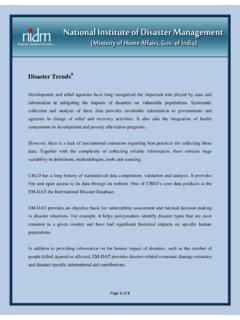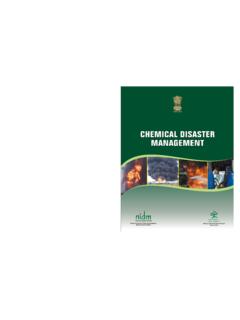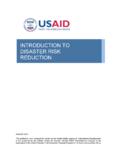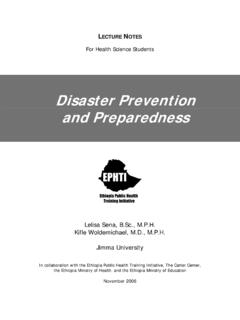Transcription of DISASTER COMMUNICATION - National Institute of Disaster ...
1 DISASTER COMMUNICATION COMMUNICATION during and immediately after a DISASTER situation is an important component of response and recovery, in that it connects affected people, families, and communities with first responders, support systems, and other family members. Reliable and accessible COMMUNICATION and information systems also are key to a community s resilience1. The role of COMMUNICATION technology has been recognized as integral to DISASTER management for a long time. Although application of COMMUNICATION technology has a role in all the four distinct phases of DISASTER management namely, mitigation, preparedness, response and recovery, most of the application has traditionally been in response and recovery phases.
2 The new COMMUNICATION and information technologies that have emerged over the last two decades lend themselves to greater possibilities of integration of different COMMUNICATION systems. The interoperability of various COMMUNICATION systems including internet, mobile- phones, fax, e-mail, radio and television is increasingly becoming functional. As a result, the possibilities for application of COMMUNICATION technologies in mitigation and prevention of disasters are also increasing2. Communications for DISASTER Management3, 4 All DISASTER emergencies and crisis events are by nature chaotic and highly dynamic, creating physical, emotional, and social disorder.
3 In such crisis events and emergencies, communications is critical at all phases of DISASTER management. Communications during emergencies incorporates a wide range of measures to manage risks to communities and the environment. Before disasters strike, telecommunications can be used as a conduit for disseminating information about the impending danger thus, making it possible for people to take the necessary precautions to mitigate the impact of these hazards. Other telecommunication applications, including remote sensing and global positioning system (GPS), have critical roles to play in tracking approaching hazards, alerting authorities, warning affected populations, coordinating relief operations, assessing damages and mobilizing support for reconstruction.
4 It is clear therefore that telecommunications play a pivotal role in DISASTER prevention, mitigation, and management. In times of natural calamity like floods, storms, cyclone, tsunami, fire etc. the usual mode of COMMUNICATION like phone, mobile etc might not work or might be lost in the calamity. The society at large must be well protected and the protection given by the police or DISASTER management forces must be instant and immediate. Thus the DISASTER management crew must be well trained and equipped with the best appliances which might help them to communicate the condition they are in and the status of the calamity in the region they work for. COMMUNICATION Technologies4, 5 Reliability is what these DISASTER management COMMUNICATION systems must focus on as the need for these systems might be more in remote parts and some time even inaccessible areas like deep seas and mountain tops.
5 We see so many people getting lost while trekking in forests or mountains. Many accidents occur during avalanche and landslides. So a COMMUNICATION system must be reliable and must be in working condition at all times. Thus wide area network with satellite signals is usually recommended. Many new discoveries and easy to use COMMUNICATION gadgets are introduced from time to time. Establishing COMMUNICATION with remote areas has been a great challenge and with the advent of satellite COMMUNICATION , the problem of connectivity to remote and far flung areas has been resolved. Satellite COMMUNICATION provides the facility of covering areas ( National and international) using one or several satellites.
6 Low Earth Orbit (LEO) satellites orbit around earth at a distance of few hundred kilometers providing the facilities of remote sensing etc. Satellite radio plays an important role in DISASTER management. Arial snap shots from the satellites also reveal the severity of the DISASTER and they can almost penetrate closer to any region to get a good view of that place. COMMUNICATION has definitely made this world as a global village wherein we can see the storm ravaging in the US live on our television sets. Our lives are well protected by the meteorically departments forecast of possible calamities. The internet technology helps us to keep in close touch with our loved ones living miles apart.
7 The moment an accident occurs to someone close to us, we are informed immediately. Wireless COMMUNICATION modules are popular these days as they use satellite signals for COMMUNICATION and we would recommend any of the Motorola VHF models that are portable for local communications and Codan NGT SRx for the long distance communications. A Portable Repeater system VHF that can be used from a vehicle and would provide communications around the area of the DISASTER is highly recommended by experts. Policy and Institutional Framework for Emergency Communications3 Policy and regulations are important elements of emergency communications planning and management.
8 One of the main hindrances to effective establishment of telecommunications for DISASTER mitigation is the lack of a legal and regulatory regime. Horizontal cooperation among specialized services at each level is as essential as the vertical lines of COMMUNICATION for emergency communications. This requires established links between DISASTER coordinators, telecommunications authorities and service providers at each level. Governments need to take important steps to eliminate the monopoly of public telecommunications enterprise and to undertake a review of current telecommunications legislation, including regulations incorporating emergency telecommunication systems and protocols to support emergency services.
9 Challenges Ahead2 1. Promoting an understanding of basic principles of effective early warning systems The effective application of emerging COMMUNICATION technologies can be realized only if they form part of a sound early warning system based on well-established basic principles. 2. Cross-sectoral integration of application of COMMUNICATION technologies Over the last few years, the application of COMMUNICATION technologies has been marred with sectoral isolation. 3. Disparities in COMMUNICATION infrastructure In the Asian region, there is significant disparity in COMMUNICATION infrastructure across countries and across different kinds of users groups.
10 While among the scientific and technical community there is a lot of enthusiasm to make use of emerging communications technologies to share real-time information as well as local knowledge and experiences, the decision makers most responsible for managing disasters have to rely on rather conventional means of COMMUNICATION . 4. Exploiting local innovation While disparities in COMMUNICATION infrastructure do exist, there is a lot of local innovation which needs to be harnessed and integrated with new technologies. 5. Towards a multi-node COMMUNICATION network for DISASTER management Traditionally, the application of COMMUNICATION technology in disasters has been inspired by parallels in military operations, which follow a well-defined command-and control structure.










